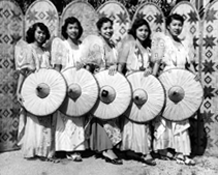


HANAPEPE MASSACRE CENTENNIAL
In 1848, under the rule of King Kamehameha III, the Great Mahele was initiated amid growing pressures from foreign settlers to modernize the Hawaiian land system. The Great Mahele divided land into three main categories: Crown Lands (belonged to the king); Government Lands (designated for public use); and Konohiki Lands (allocated to the ali'i and other high-ranking officials). Significantly, the Mahele marked a shift from communal land ownership to individual property rights. By statute and by process, the common people were mostly shut out from access to land ownership. Within a few years the mostly haole sugar agricultural interests had obtained leases or outright possession of a major portion of the best cane land.
From June 21, 1850, laborers were subjected to a strict law known as the Masters and Servants Law, enacted just a few weeks after the founding of the Royal Hawaiian Agricultural Society. Two forms of labor contracts were legalized: apprenticeships and indentured service. Under the latter law, absenteeism or refusal to work could result in a contract laborer to be apprehended by the district magistrate or police officer and subsequently sentenced to work for the employer an extra amount of time after the expiration of the original contract, usually double the time of the absence. For a hundred years, the "special interests" of the planters would control unhindered, the laws of Hawai‘i as a Kingdom, a Republic and Territory.
After experimenting with Native Hawaiian labor, then Chinese and Japanese migrants as the primary plantation labor force, plantation companies sought what they thought to be more docile labor pool. By the 1920 the majority of sugar plantation workers were from the Philippines, a recently acquired territory of the U.S. However, like the preceding workers, the Filipinos recognized their exploited existence and organized for better pay and working conditions.
On September 9, 1924, a bloody incident occurred between striking Filipino sugar plantation laborers and local police in Hanapepe, Kauai, resulting in the death of sixteen Filipinos, four policemen and many more wounded. Many Filipinos were arrested, imprisoned, and deported. Variously called the Hanapepe Massacre, Hanapepe Riot and the Battle of Hanapepe, the details of the event have been shrouded in controversy. Over the past century a definitive understanding of what had taken place has yet to be established.
In particular, how the incident in Hanapepe started and unfolded remain unclear. Also unclear is the extent labor leader, soon-to-be-exiled Pablo Manlapit, participated or was responsible for the incident, as HSPA had already been targeting Manlapit to be expelled from Hawaii prior to the incident. To commemorate the centennial of the Hanapepe Massacre, FAHSOH partered with the Hawaii State Archives to assist researchers and community historians develop a deeper and broader understanding of the event by scanning and making available online government records related to the Hanapepe Massacre, labor leader Pablo Manlapit and judicial actions.
Included are records and correspondence from Governor Wallace Rider Farrington, Attorney General Pau, the Department of Land and Natural Resources and Quasi-Judicial Executive Actions. Access to these records are on the Hawaii State Archives website:
Quasi-Judicial Executive Actions: Commutations of Sentence, Parole
Quasi-Judicial Executive Actions: Pablo Manlapit
Department of Land and Natural Resources: Filipino Strikers' Camp
Attorney General Pau Case Files: Filipino Plantation Strike, Tampering with Witnesses, Hanapepe Riot
Attorney General Pau Case File: In the Matter of Pablo Manlapit
Governor Wallace Rider Farrington: Hawaiian Sugar Planters' Association
Governor Wallace Rider Farrington: Strike, 1924, Filipino Plantation Laborers
HOME
|
Filipino-American
Historical Society of Hawaii
|
Help
Exhibits
| Publications
|
Collections
| Student/Teachers
Kasaysayan &
Ka Moaukala | Centennial
Display | Philippine
History |
Contact
Us
Copyright © 2006 by the Filipino-American Historical Society of Hawaii.